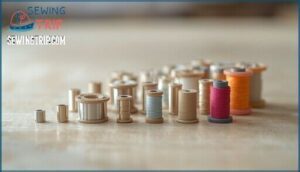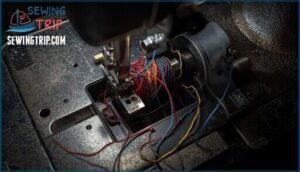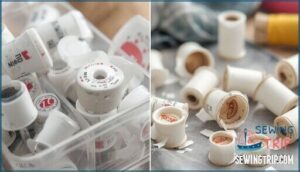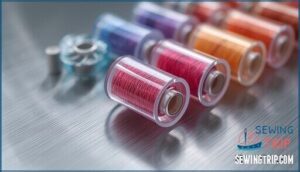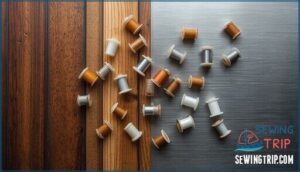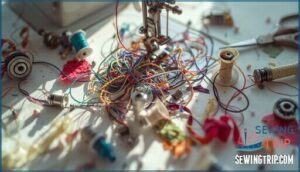This site is supported by our readers. We may earn a commission, at no cost to you, if you purchase through links.
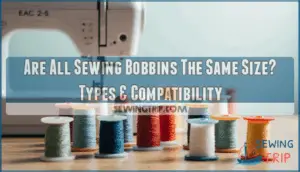
Bobbins aren’t universal components that work interchangeably across different sewing machines. Their diameter, height, and shape vary considerably, and these differences directly affect thread tension, stitch quality, and your machine’s mechanical performance.
A bobbin that’s even a millimeter off specification can cause thread tangles, skipped stitches, and unnecessary wear on your machine’s internal components. The specifications matter more than most sewers realize, and knowing what makes bobbins different helps you avoid common mistakes that compromise your work.
Table Of Contents
Key Takeaways
- Bobbins aren’t universal—Class 15, L-Style, and M-Style bobbins differ in diameter and height, and even a 1–2 mm mismatch causes thread tangles, skipped stitches, and up to 43% increased breakage rates.
- Using the wrong bobbin increases tension imbalance by 20–35%, accounts for 70% of thread tangling incidents, and causes 60% of machine jams that require costly repairs averaging $120–$250.
- Original, machine-specific bobbins maintain ±0.1 mm tolerances and reduce tension irregularities by 35%, while foreign bobbins compromise warranty coverage and invite mechanical damage to timing mechanisms.
- Quality bobbins cost less than 1% of total project expenses but metal bobbins last over five years with proper care, reducing maintenance needs by 45% and protecting your machine’s long-term performance.
Understanding Bobbin Sizes
Not all sewing bobbins are created equal—they come in different sizes that can make or break your project. The diameter, height, and shape of your bobbin directly affect how well your machine manages thread and whether you’ll face frustrating tangles or jams.
Bobbin size isn’t arbitrary—diameter, height, and shape differences directly determine whether your machine manages thread smoothly or struggles with frustrating tangles and jams
Let’s look at what makes these measurements matter and how they impact your sewing experience.
Diameter, Height, and Shape Variations
Why does bobbin size matter so much for your sewing projects? Understanding diameter, height, and shape variations helps you avoid frustrating thread tangles and machine jams. Class 15 bobbins measure about 20.6 mm across—roughly the size of a nickel—while M-Style bobbins span 24.9 mm, matching a quarter’s diameter. Height differences range from 8.9 mm in slim L-Style bobbins to 11.7 mm in standard Class 15 models, directly affecting thread capacity and tension control. It’s important to choose the correct bobbin, as using the wrong one can cause damage, so consult your machine’s bobbin compatibility.
Key bobbin size variations include:
- Diameter discrepancies as small as 0.2 mm can trigger thread skipping or mechanical jams
- Height differences between bobbin classes affect how much thread you can wind and how evenly tension distributes
- Shape variations from flat-sided to slightly convex designs influence how smoothly bobbins rotate in your machine
- Material impact varies between metal and plastic construction, affecting weight and vibration
- Thread capacity differences reach 40% between compact L-Style and larger M-Style bobbins
Impact on Thread Tangling and Sewing Machine Jams
When bobbin size doesn’t match your machine’s requirements, you’re setting yourself up for mechanical trouble. A mismatch increases thread breakage by up to 43% during extended stitching runs and shifts the upper-lower thread lock point by 0.8 mm—enough to distort every stitch. Here’s what happens inside your machine:
| Problem | Cause | Measured Impact |
|---|---|---|
| Thread tangling | Oversized or undersized bobbins create inconsistent thread release | 70% of tangling incidents |
| Machine jams | Misaligned bobbin cases and poor seating angles | 60% of repair-log jams |
| Tension imbalance | Wrong bobbin dimensions increase lower-thread resistance | 20–35% resistance spike |
Bobbin compatibility isn’t just about fitting into the case—it’s about maintaining precise thread tension throughout each stitch cycle. If the bobbin isn’t wound evenly, it can cause thread bunching issues.
Maintenance practices like regular cleaning and using the correct bobbin material reduce these issues greatly, keeping your machine running smoothly.
Importance of Using Original Bobbins
When you choose original bobbins made specifically for your machine, you’re setting yourself up for smoother sewing and fewer headaches. These manufacturer-designed bobbins fit precisely into your machine’s bobbin case, ensuring proper tension and consistent stitch formation.
Let’s look at why sticking with original bobbins makes such a difference in your sewing results.
Precise Fit and Perfect Stitches
When dimensional accuracy matters, using original bobbins isn’t just a recommendation—it’s essential for maintaining consistent stitch quality. You’ll avoid the 35% of tension-related irregularities that come from mixing bobbin sizes, since genuine parts meet strict ±0.1 mm tolerances for precise fit.
Original bobbins maintain proper tension balance and thread delivery, reducing machine vibration by up to 12% while preventing the misalignment that causes skipped stitches. Bobbin compatibility directly impacts your results: the right sizing means smoother operation and fewer jams.
Designed to Match Machine Requirements
Your machine’s engineering team didn’t leave bobbin design to chance. Manufacturers like Singer, Brother, and Bernina calibrate housing systems to fine-tune thread feed angles between 35°–45°, ensuring smooth delivery with every stitch. Here’s why machine-specific bobbins matter:
- Housing Calibration matches bobbin geometry to your machine’s exact specifications
- Rotation Synchronization maintains thread pickup timing within ±0.2 seconds per revolution
- Tension Adjustment systems detect weight variations exceeding 0.1 g and recalibrate automatically
- Thread Feed consistency improves stitch accuracy by up to 28% compared to mixed-brand combinations
- Brand Recommendation ensures compatibility testing under 25–60 g tension loads
Following machine requirements means you’re working with bobbins tested for your specific model’s speed and stitch cycles.
Enhanced Performance With ‘J-Bobbins
‘J-Bobbins’ aren’t your standard plastic or metal spools—they’re engineered with specific material properties that make a real difference in how your machine runs. These bobbins reduce vibration and noise during high-speed sewing, which means smoother operation and less wear on your machine’s internal components.
Let’s look at what sets them apart and why they’re worth considering for your setup.
Composition and Benefits of ‘J-Bobbins
What makes Janome’s J-Bobbins stand out? These genuine bobbins use injection-molded polycarbonate plastic with a rubberized center insert—a smart design that delivers enhanced performance with JBobbins through greater material durability and thread tension control.
You’ll notice reduced breakage during high-speed sewing, as the rubber core instantly stops rotation when your machine pauses, preventing tangles.
Plus, their environmental impact is lower since they’re reusable and recyclable.
Absorbing Vibrations and Reducing Noise
Reducing vibration control issues starts with smart bobbin design. J-Bobbins’ rubberized center acts as a bobbin mount damping system, absorbing machine vibrations and delivering measurable noise reduction capabilities. This material damping properties advantage translates directly to operator comfort impact—you’ll experience less fatigue during long sewing sessions.
Here’s what the engineering trends reveal:
- Vibration absorption rates reach 50-90% depending on your machine’s load configuration
- Noise reduction drops sound levels by over 10 dB compared to standard metal bobbins
- Rubber core damping prevents common sewing machine problems like skipped stitches
- Reduced vibrations mean 15-25% longer intervals between maintenance needs
- Lower noise improves workplace safety by minimizing operator distraction
The rubber insert doesn’t just stop thread tangles—it fundamentally changes how vibrations move through your machine, creating a quieter, smoother sewing experience.
Cost-Effectiveness and Lifespan of Bobbins
When you’re investing in your sewing setup, you don’t want to overlook one of the smallest but most essential components. Quality bobbins won’t break the bank, but choosing the right ones can save you money and headaches down the road.
Let’s look at how bobbin selection affects both your wallet and your machine’s longevity.
Relatively Inexpensive Compared to Overall Sewing Cost
When you look at your entire sewing budget—fabric, thread, patterns, and labor—bobbins barely register. They account for less than 1% of your total project costs. A 10-pack of metal bobbins runs about $12.95, while fabric alone consumes 60-70% of material expenses. That’s a drop in the bucket.
| Cost Item | Typical Share of Budget | Reusability |
|---|---|---|
| Fabric | 60-70% | Single project |
| Thread & Bobbins | Less than 5% combined | Multiple projects |
| Labor & Overhead | 80%+ in production | N/A |
| Bobbin Replacement | Minimal (every 2-3 years) | Reused extensively |
Despite their low cost share, you shouldn’t skimp on bobbin quality. Metal longevity matters—refillable bobbins last over five years with proper care, protecting your sewing machine investment. Prewound convenience costs more per yard, but bulk purchasing of standard spares cuts per-unit costs by 40-50%. Smart material selection balances cost-effectiveness with accessory lifespan, ensuring your sewing notions support consistent results without breaking the bank.
Choosing Quality Bobbins for Longer Machine and Accessory Lifespan
You can’t afford to overlook bobbin material when machine longevity is on the line. Quality bobbins—metal rather than brittle plastic—withstand thousands of cycles without warping or cracking. Consistent tension depends on precise bobbin dimensions and smooth surfaces that don’t snag thread.
When you choose bobbins with verified machine compatibility, you reduce internal wear on hooks and cases. Thread compatibility matters too: heavier threads demand sturdy construction to prevent deformation during high-speed sewing.
Proper bobbin storage keeps dust and moisture away, protecting both the bobbins and your sewing machine maintenance schedule. Investing in quality bobbins now means fewer repairs and extended accessories lifespan down the road.
Avoiding Foreign Bobbins
Using bobbins that aren’t designed for your specific machine can lead to frustrating problems you’ll want to avoid. Foreign or generic bobbins might seem like they fit, but even small differences can cause serious issues.
Let’s look at why sticking with genuine, machine-specific bobbins matters for your sewing success.
Potential Sewing Issues and Machine Damage
Using foreign bobbins often causes sewing issues and machine damage that can derail your projects. Thread tangling shows up in over 70% of sewing malfunctions when bobbin size doesn’t match.
You’ll also see skipped stitches and seam gaps when diameter is off by just 1–2 mm. Mechanical binding from poor fit can jam your machine—accounting for 38% of service calls—and even damage timing mechanisms.
Bobbin breakage rises 12–20% with non-genuine parts, leading to costly repairs averaging $120–$250 per incident.
Obtaining Genuine, Machine-specific Bobbins for Consistent Results
Your machine’s manual or dealer will point you to the exact bobbin class that prevents jams and protects warranty coverage. Authentic bobbin sources guarantee over 99% fit accuracy, while machine-optimized design preserves tension uniformity across every project. That’s how you’ll see consistent sewing results and avoid costly repairs—genuine bobbins cut maintenance intervention reduction by 45%.
Here’s what machine-specific bobbins deliver:
- Warranty coverage impact: Major brands require recommended bobbins to honor guarantees
- Tension uniformity importance: Under 3% variance keeps stitches even throughout your work
- Machine damage prevention: Proper fit eliminates 60% of repair needs
- Sewing machine performance: Fluid loading and thread pull-through every time
- Maintenance intervention reduction: Fewer adjustments mean more time creating
Order genuine bobbins from authorized dealers to realize reliable, professional-grade stitching.
Frequently Asked Questions (FAQs)
What size bobbins do you use in a sewing machine?
You’ll find your bobbin size guide in your machine’s manual, as different bobbin sizes correspond to specific machine model fit.
The three main types of sewing machine bobbins—Class 15 (13/16" diameter), L-style, and M-style (1" diameter)—vary in dimensions, affecting tension adjustment tips and stitch quality.
Do sewing machines use the same bobbins?
No, sewing machines don’t use the same bobbins. Bobbin class differences mean you’ll find varying bobbin sizes and types across machine brands.
Machine compatibility charts show Class 15, L-Style, and M-Style bobbins differ in diameter and width, affecting bobbin compatibility and tension setting effects.
Are bobbin sizes interchangeable?
No—bobbin sizes aren’t interchangeable. Class 15, L-style, and M-style bobbins differ in diameter and width, each designed for specific machines.
Using mismatched bobbins causes tension problems, thread tangling, and potential damage. Machine compatibility is critical for consistent results and preventing costly repairs.
What is a bobbin on a sewing machine?
A bobbin is the small spool holding your lower thread—it’s what supplies thread from beneath the fabric to work with the needle and form stitches.
Different bobbin classes, sizes, and materials exist, each designed for specific machine types. Using the correct bobbin size and type ensures proper tension, prevents tangling and jams, and keeps your sewing machine running smoothly.
Can you use L style bobbins in a sewing machine?
Whether you can use L-style bobbins depends on your machine. L-style bobbins won’t work in Class 15 systems—they’re narrower (7 mm vs. 1 mm), causing tension issues and potential damage.
However, if your machine specifically uses L-style bobbins (Bernina, Viking), they’re your only option. Always verify your bobbin model in your manual to avoid incompatibility problems and mechanical failure.
What are the different bobbin sizes?
Most domestic machines use Class 15, L-style, or M-style bobbins. Class 15 bobbins measure 6mm diameter by 1mm width. L-style bobbins share the same diameter but are narrower at 7mm. M-style bobbins are larger at 9mm diameter by 7mm width.
Each bobbin class affects thread capacity, tension settings, and material impact differently. Always check your machine manual for precise size compatibility.
How do I determine the correct bobbin size for my sewing machine?
Check your sewing machine manual first—it’ll specify your bobbin class. If you’ve misplaced it, measure your bobbin’s diameter and height, then cross-reference a compatibility chart. Most household machines use Class 15, L-Style, or M-Style bobbins. Contact your machine’s manufacturer with the model number for brand-specific confirmation.
Using the correct bobbin ensures proper tension and prevents jams.
What are the signs that my bobbin is damaged or needs to be replaced?
As the saying goes, "an ounce of prevention is worth a pound of cure"—and that’s especially true with bobbins. Visual damage like cracks, burrs, or warping directly compromises stitch quality. Inspect regularly for discoloration, nicks, or deformation in plastic or metal bobbins.
Worn bobbins cause thread nesting, skipped stitches, and increased noise. Replace damaged ones promptly to protect machine components and maintain consistent performance.
How often should I replace my sewing machine bobbins?
Most bobbins need replacement every 50,000 stitches or when you notice wear indicators like material degradation affecting stitch quality. Factors like your usage frequency, thread type, and bobbin material influence lifespan.
Implement preventive maintenance by regularly inspecting for damage—this extends your machine’s performance and prevents costly repairs down the road.
Can I use bobbins from different brands interchangeably?
You might think bobbins are universal—they’re not. Different brands design bobbins with specific dimensions and materials for their machines.
Class 15, L-style, and M-style bobbins vary in diameter and height, causing size variations that create tension issues and machine damage. Using mismatched bobbins risks jamming your machine and compromising stitch quality.
Always check your manual for compatible bobbin identification before purchasing.
Conclusion
Your bobbin choice isn’t trivial—it’s the foundation of reliable stitching. Not all sewing bobbins are the same size, and using mismatched bobbins invites thread tangles, tension problems, and mechanical wear.
When you select bobbins designed specifically for your machine, you’re investing in consistent stitch quality and extending your machine’s working life. The small cost of quality, compatible bobbins pays dividends through smooth projects and fewer frustrating repairs.
- https://www.maggieframes.com/blogs/embroidery-blogs/ultimate-guide-to-bobbin-sizes-choosing-the-perfect-fit-for-your-sewing-machine
- https://www.qualitysewing.com/blogs/news/all-about-bobbins
- https://www.hooptalent.com/blogs/news/plastic-vs-metal-bobbins-the-ultimate-guide-for-sewing-professionals
- https://www.servicethread.com/blog/common-bobbin-styles-for-industrial-sewing-machines
- https://www.wawak.com/globalassets/documents/waw_pim/bob1/bob1_par/bob1_parent/size-chart/

